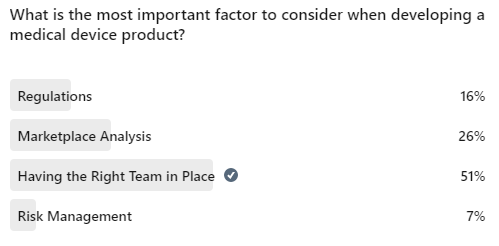|
Medical device companies play a critical role in advancing healthcare as their ability to diagnose, monitor, and treat medical conditions allow patients like you and I the opportunity to recover and live longer. Device companies carry a heavy burden on our behalf and that burden starts with product risk. One of the biggest challenges an OEM medical device organization will be faced with is managing risk, especially during the early stages of product development. The integration of risk management into design control (ISO 14971) is essential for identifying, assessing, and mitigating potential risks associated with the design and development of a medical device. Given risk management is a part of nearly every development process, and is a primary focus of all regulatory agencies like the U.S. Food and Drug Administration (FDA) and the European Medicines Agency (EMA), why is it then so many medical device companies struggle with sound risk management strategies? The failure to address risks adequately can lead to a whole host of problems ranging from regulatory non-compliance, compromised patient safety, financial setbacks, and in severe situations criminal prosecution of executives. Needless to say, understanding why medical device companies come up short with their risk management strategy and how you can avoid that for yourself is key to your future success. In this article, we will explore some of the key reasons behind risk management failure. Most Common Risk Failure Factor - Inadequate Understanding of Regulatory Requirements: One of the primary reasons for failure in risk management is an insufficient understanding of the complex and evolving regulatory landscape. Medical device companies must navigate a web of regulations, standards, and guidelines to ensure compliance. Failing to keep abreast of these requirements can result in flawed risk assessments, inadequate risk mitigation measures, and ultimately, regulatory sanctions. Poor Integration of Risk Management into Product Development: Successful risk management should be an integral part of the product development lifecycle. However, some companies make the mistake of treating it as a standalone process rather than integrating it seamlessly into every stage of development. When risk management is an afterthought, essential risks may be overlooked, leading to suboptimal product designs, increased failure rates, and compromised patient outcomes. Lack of Cross-Functional Collaboration: Effective risk management requires collaboration across various departments, including research and development, regulatory affairs, quality assurance, and manufacturing. Failure to establish clear communication channels and encourage cross-functional collaboration can result in siloed decision-making. This lack of coordination can lead to critical risks being underestimated or missed entirely. Insufficient Resources and Expertise: Some medical device companies fail in risk management due to resource constraints and a shortage of expertise. This can manifest in inadequate training for personnel responsible for risk management, insufficient allocation of time and budget, and a lack of access to external expertise. Without the necessary resources, companies may struggle to conduct comprehensive risk assessments and implement effective risk mitigation strategies. Overemphasis on Short-Term Goals: Pressure to meet short-term financial goals can sometimes lead companies to prioritize speed to market over thorough risk analysis. This can result in hasty decision-making and inadequate risk identification and mitigation. Companies need to strike a balance between meeting market demands and ensuring the safety and efficacy of their medical devices in the long run. Failure to Learn from Industry Incidents: The medical device industry has witnessed several high-profile incidents related to product failures and patient harm. Failure to learn from these incidents and implement lessons learned into future risk management strategies can perpetuate the same mistakes. Companies must actively analyze industry incidents, update risk management processes accordingly, and continuously improve their practices. Ineffective Communication with Stakeholders: Communication is crucial in risk management, both internally and externally. Companies that fail to communicate effectively with their stakeholders, including regulatory bodies, healthcare professionals, and patients, may face increased scrutiny and regulatory challenges. Transparency and open communication are essential for building trust and demonstrating commitment to patient safety. In the highly regulated and dynamic field of medical devices, effective risk management is not just a regulatory requirement - it is a fundamental aspect of ensuring patient safety and the success of a company. Understanding the pitfalls that lead to failures in risk management can help medical device companies proactively address these challenges. By prioritizing compliance, integrating risk management into every stage of product development, fostering cross-functional collaboration, and learning from industry incidents, companies can enhance their risk management strategies and contribute to the advancement of healthcare with safe and reliable medical devices. The quickest way to overcome a business challenge is to get help from those who are experienced in besting your beast! The team at Square-1 Engineering is comprised of a variety of technical and project management professionals who are subject matter experts in the areas of NPD, Quality, Compliance and Manufacturing Engineering. Learn more about how we can solve your work and project problems today to get you back on track!
0 Comments
We're breaking the mold!
Medtech Snapshot returns with an enticing debate as #RAQA medtech industry experts Stephanie Rallis-Daw, RAC, CQE, CMDA and Robert Lahaderne, MBA spar on the topic of "When starting a new job/ project, what is the most common medtech compliance shortfall you can expect to encounter at your new company?" New to Medtech Snapshot? Check out our archive of past episodes at https://www.sqr1services.com/white-papers/category/snapshot covering topics in R&D, Quality, Clinical and Manufacturing. Honey for your eyes and ears, friends. #medtech #snapshot #podcast #medicaldevice #compliance #quality #regulatory #documentation #training EU MDR/ IVDR PROPOSED PUSH1/25/2023 DID YOU KNOW On January 6, 2023 the European Commission, a political and regulatory steering committee consisting of a group of 27 Commissioners, known as 'the College', adopted a proposal to give more time to device OEMs to certify medical devices under EU MDR to mitigate the risk of shortages. The proposal, which now needs to be adopted by the European Parliament, could push out MDR requirements several years. Higher risk devices such as pacemakers and joint implants would have a shorter transition period till December 2027, whereas lower risk devices, such as syringes or reusable surgical instruments wouldn't be until December 2028. WHAT DOES THIS MEAN FOR YOU? Regardless of EU Parliament's decision to potentially extend MDR, device OEMs should consider the following as we hedge through 2023: 1. Strategies for US product approval and or commercialization will continue to increase as OEMs seek alternative pathways to potentially avoid EU MDR compliance. 2. As a result of #1, support to aide OEMs in their go-to-market strategy will intensify causing a shortage for resources, while potentially lengthening the process to get to approvals (supply & demand constraints - notified bodies and consulting firms experience increases in demand causing support shortages). This will be especially true with remediation work. 3. The idea of putting off or slowing MDR related efforts in the interim to re-focus on other activities may provide momentary relief, however it also creates a long-term liability in the business. This liability comes with a variety of future unknowns: regulatory landscape, inflation, cost of resources, CRO and notified body constraints, etc. If you must achieve MDR compliance our recommendation is to get it done and over with in the present. 4. Work associated with achieving MDR compliance can be easily underestimated, especially if you have legacy product where your CE mark was granted pre mid 2000s. The burden to meet MDR requirements may be steep, which is all the more reason to avoid procrastinating said efforts as outlined in #4. SOLVING THE PROBLEM The quickest way to overcome a business challenge is to get help from those who are experienced in besting your beast! The team at Square-1 Engineering is comprised of a variety of technical and project management professionals who are subject matter experts in the areas of NPD, Quality, Compliance (and yes - remediation) and Manufacturing Engineering. Learn more about how we can solve your compliance problems while besting your EU MDR beast! Learn about Square-1 Engineering's mission and what it means to be fearless!
The results are in from our Square-1 Engineering online poll...."What are the top 2 most frequent reasons warning letters/ citations are issued by the FDA?"
Listen in as our managing director, Travis Smith, covers the results of he poll while sharing commentary from the medical device community. Need help dealing with an audit or warning letter? Learn more about our support capabilities at https://lnkd.in/g7NX_8pw #poll #fda #capa #complaints #regulatory #quality #medtech #square1engineering Recently our company published a poll online offering up the following question for the medical device community: “What is the most important factor to consider when developing a medical device product?” At the close of the poll dozens of people had cast their votes for what they believed to be the factors affecting product development the most. The poll options included:
If you have been in industry for any length of time you know there are dozens of factors which can and often have a direct impact on the product development process. While there are dozens to consider, such as PRS (Product Requirement Specification), planning, user experience, DFM, etc. what we know to be true is each of these factors carry varying weights of impact. They are not all equal in measure or influence. As our poll launched and picked up steam one of the four factors listed as an option began to take a commanding lead. The respondents, who are largely made up of medical device professionals and executives, had identified a common factor which stood above the rest in its ability to impact positively or negatively the product development process. What was this most important factor? Would you have guessed ‘Having the Right Team in Place’ is the number one factor which determines success when developing a medical device product? ‘Having the Right Team in Place’ was identified by 51% of the respondents as being the most important factor which directly contributes to the success of medical device product development. The other options broke down as follows: Simply put – having the right team in place covers all of the other areas that potentially could produce challenges during the product development cycle. Whereas the inverse is certainly all too true. When we have the wrong team in place, or teammates lacking the capabilities to facilitate their job as needed by the company, inevitably problems go arise which hold back otherwise good opportunities and technology offerings. Jim Collins, celebrated author (books like ‘Good to Great’ & ‘Built to Last’) and business management guru, is quoted as saying “Leaders of great companies start by getting the right people on the bus, the wrong people off the bus, and the right people in the right seats.” What this means is it’s more about the people than it is the technology or problem you’re solving. This is an important lesson, especially for first time entrepreneurs and startup executives. You can have the best product idea in the world, one that is in high demand, but if you don’t have the right team in place you’ll most likely spin your wheels while blowing out copious amounts of money in the process. We’ve also seen this reality in person dozens of times. As a medical device consulting firm we work with a lot of companies, both start up and conglomerate alike. One of the consistent characteristics we see within the companies which are able to drive success, often times repeated success, is their management team is comprised of experts in their particular field who know how to both lead and operate in the weeds. They both strategic and tactical, able to plan for the long term while addressing todays shorter term needs. As a result, they know how the job is done and therefore can either lead or delegate those tasks helping to guide their department or team to successful completion. When you have the right people on the team (your bus) you will then find opportunities (the medical problem you’ll solve) to move forward with. Following this process you’ll also have a far better chance of facilitating that opportunity through the development process and into commercialization, or acquisition. Remediation in the medical device industry often adopts a similar saying you’ll hear motorcyclists say when referencing laying their bikes down [accidents], “it’s not if it will happen, it’s when”.
With so many companies over the years going through major remediation efforts one would think by now most people in the business would have a good appreciation for what a successful process looks like to navigate through FDA remediation projects. Yet, many people will tell you the remediation projects they’ve been a part of were messy, unorganized and a galactic waste of money. Unfortunately, when we’re faced with remediation there is no choice other than to mend our broken wings before flying home for the summer. One of the biggest issues with remediation projects is many people in the company look at it as a ‘quality’ issue. Meaning, “it’s the quality departments problem, let them deal with it because we have our own projects and deadlines.” Shocking as this may be, I literally was told this several years ago from an R&D Director whose company was going through a sizable remediation overhaul. Needless to say he wasn’t operating as a team player and certainly wasn’t aligned with what was best for the company. Which sparks an interesting question – if I have a remediation project ready to get underway, what are the things I can do in order to ensure it succeeds? Regardless of the project size, these are the four things you must consider as a top priority in your next remediation effort: 1.Establish clear, consistent and easy internal communication protocol for the project This is one of the most overlooked parts of a large scale project. It’s especially important when considering cross functional company divisions and the people accountable to working towards successful completion. When people are misinformed or don’t know what’s going on you can be certain it will slow your project down and cause further product quality and procedural issues down the road. 2.Get a GREAT ‘lobbyist’ You’ll need someone acting as the liaison between your company and the FDA. Typically, this person comes from your QA/ RA group, but is that the right person? Don’t assume your de facto executive in QA / RA is the best for the job. Ensure your company aligns itself with a proven individual who has relationships within the FDA and knows how to play the game. This will pay off huge dividends in the end as they’ll know how to navigate delicate situations, get continuances and or leniencies where able. 3.Ensure your entire company (especially executive management) is onboard Everyone in the organization, bottom up, needs to understand why this project just went to the top of the work list. Everyone needs to be bought in and rowing in the same direction, otherwise you’ll experience cumbersome internal issues as mentioned above, which waste time, money and energy. 4.Learn how to manage cost early on Often companies will use a consulting group to lead or help work through their remediation efforts. All to often the selection process for that supplier comes down to a key relationship within the company which basically side tracks any formal vetting process of other possible suppliers. Cost becomes a 2nd or 3rd consideration over a relationship. This can be disastrous as selecting the wrong supplier to help you with a remediation project can end up costing you thousands, if not hundreds of thousands, of dollars extra down the road. Case in point – when you use suppliers that fly in consultants to project work you are literally paying more than double the cost for that service just because those resources weren’t local. Flights, housing, food, per diems, auto travel, etc. adds up incredibly fast. I’ll admit, sometimes the best solution is an out of town supplier, however be sure to do your homework here before you settle on the one supplier that’s going to get your company back on track. Key Take Away: If you’re heading into a FDA remediation project it is paramount to set up a company wide communication protocol which provides detail to everyone Action Item: Remember – it’s not ‘if’ but ‘when’ you’ll find yourself in a situation where you’re stuck going through FDA remediation. Therefore, you must be proactive. Before you need the help, begin compiling data on suppliers that could help with a possible remediation projects. Compare their capabilities, learn how they would approach a potential project, how do they charge, etc. Once you’ve done your homework you’ll then have all the necessary information upfront to make a strategic and informed decision when it comes time to dive into remediation. [Note] this article intentionally does not cover the tactical approaches to FDA remediation as there are hundreds of articles and sources providing that information. This article covers the intangible parts of projects of this nature, the ones that most often go overlooked. About the AuthorTravis Smith is the founder and managing director of Square-1 Engineering, a medical device consulting firm, providing end to end engineering and compliance services. He successfully served the life sciences marketplace in SoCal for over 15 years and has been recognized as a ‘40 Under 40’ honoree by the Greater Irvine Chamber of Commerce as a top leader in Orange County, CA. Categories
All
Archives
April 2024
|
Visit Square-1's
|
|










 RSS Feed
RSS Feed


